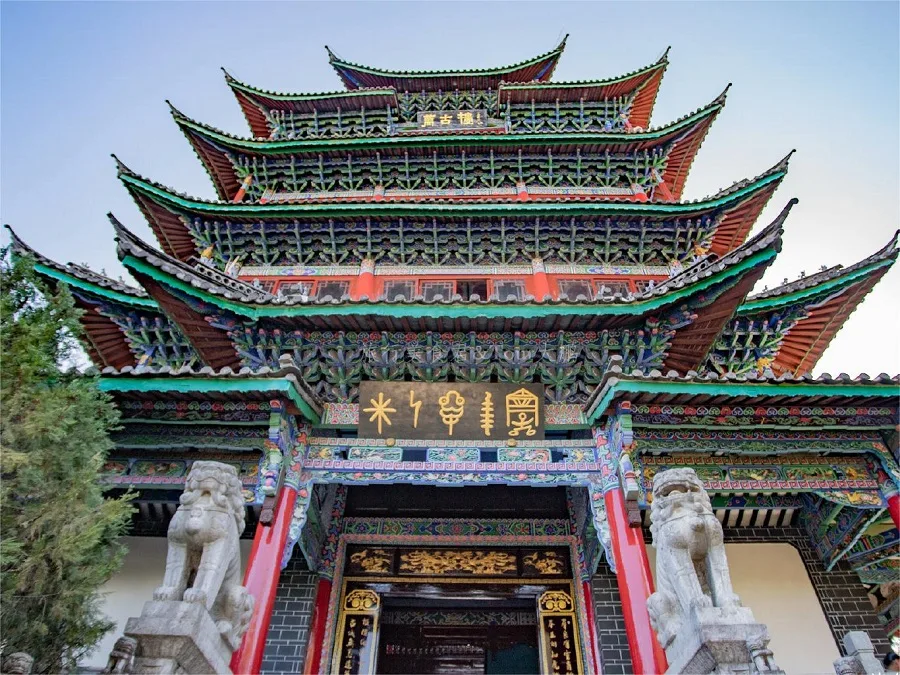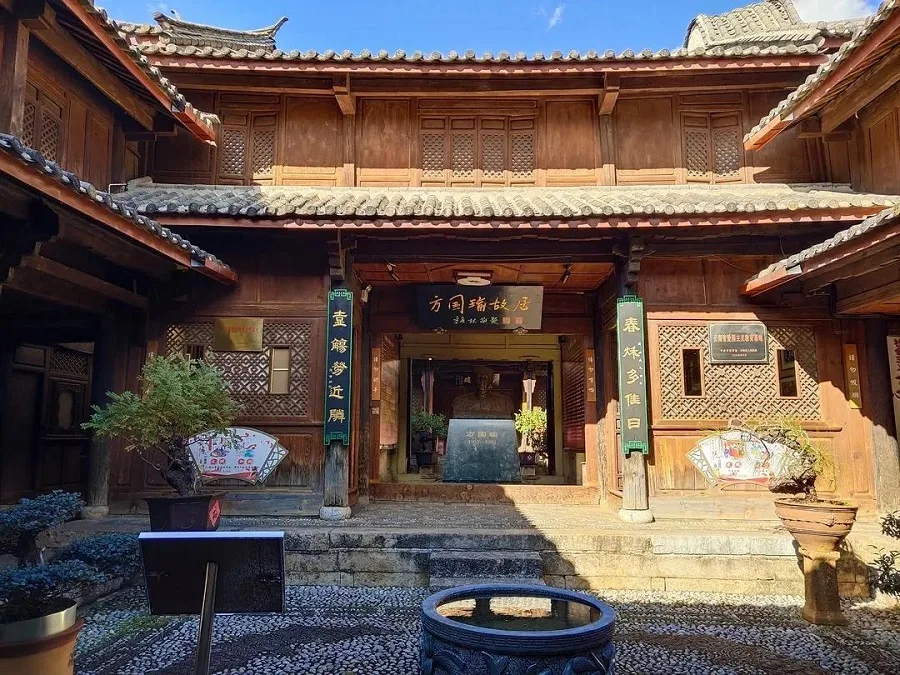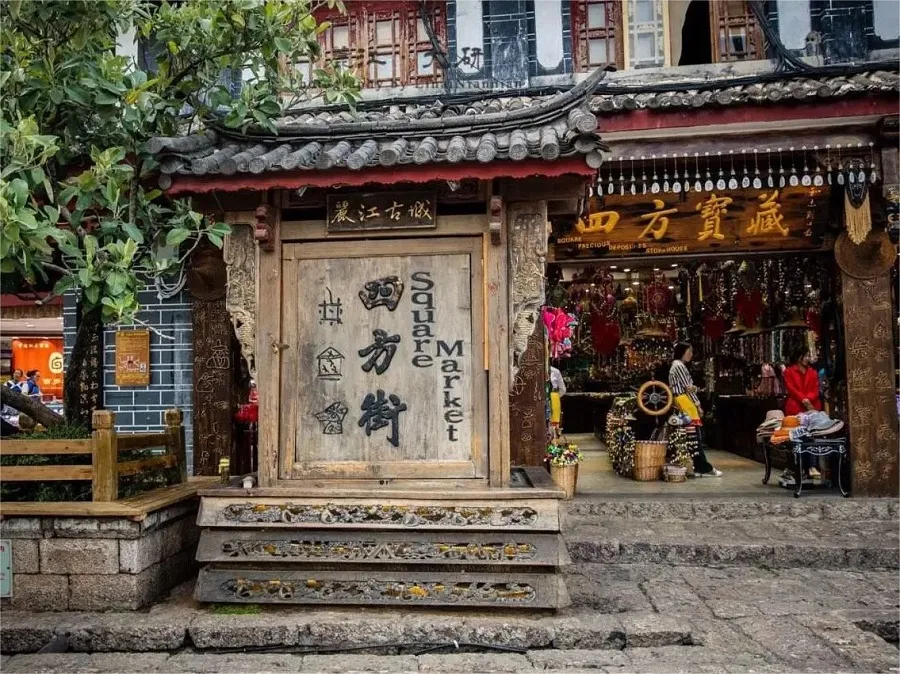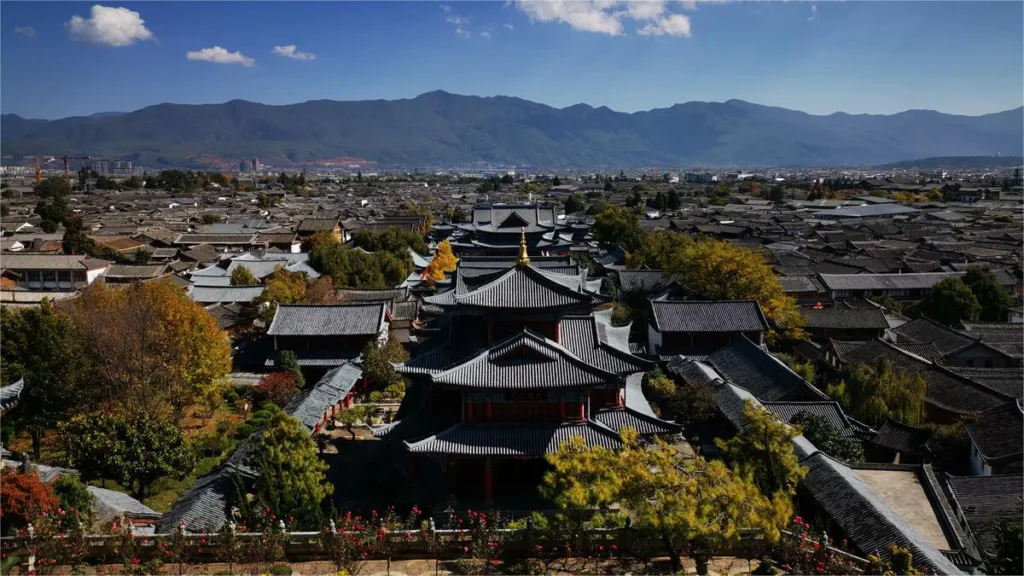The Old Town of Lijiang (丽江古城) began to take shape in the early Southern Song Dynasty. Known as “Dayan” during the Ming Dynasty, it sits at the heart of the Lijiang Plain, surrounded by verdant mountains and flowing green waters, resembling a piece of jade inkstone, hence its name. As one of the most famous towns along the Ancient Tea Horse Road, it boasts a history of eight or nine centuries. Inside the ancient town, wooden houses with blue tiles, ancient streets and lanes, and small bridges over flowing water create a picturesque scene. Standing on East Avenue of the old town, one can gaze upon the distant Jade Dragon Snow Mountain.
The Old Town of Lijiang, with water as its core, features a unique layout of waterways and alleys. The dense network of bridges is one of its most prominent characteristics. In terms of external appearance and structure, the ancient residential buildings in the old town blend the architectural techniques of the Han people from the Central Plains with those of the Tibetan and Bai ethnic groups. This fusion has resulted in distinctive architectural styles characterized by upward-sloping earthen walls, layered roofs, small blue tiles, and wooden frameworks.
Table of Contents
- Basic Information
- Location and Transportation
- Highlights of Lijiang Old Town
- Vlog about Lijiang Old Town
Basic Information
| Estimated Length of Tour | 1 day |
| Ticket Price | Free |
| Opening Hours | 24 hours a day throughout the year |
| Telephone Number | 0086-0888-5111118 |
Location and Transportation
The Old Town of Lijiang is situated in the center of the Old Town District in Lijiang City, Yunnan Province, China. To get there, you can take bus 2A, 2B, 3, 4, 7, 10, 11, 14A, 14B, 15A, 15B, 18, 19A, 19B, 24A, 24B, 26, 27, 30, 31, 32, 36, 101, 105, 202, or 209 and get off at Zhongyi Market Stop (忠义市场站).
Highlights of Lijiang Old Town
Mu’s Mansion (Mu Fu)

Originally serving as the residence of the Mu family, hereditary chieftains of Lijiang, Mu’s Mansion is situated at the eastern foot of Lion Hill within the old town. Dating back to the Yuan Dynasty (1271-1368), it was reconstructed in 1998 and converted into the Lijiang Ancient Town Museum. Covering an area of 46 acres, the mansion comprises 162 rooms arranged along a central axis stretching 369 meters. Notable structures within the mansion include the Sanqing Hall, Yuyin Tower, Guangbi Tower, Hufa Hall, Wanjuan Tower, Yishi Hall, and Zhongyi Archway. The mansion houses eleven imperial plaques bestowed by successive emperors, reflecting the rise and fall of the Mu family. The TV drama “The Storm of Mu’s Mansion” was filmed here, recounting the turbulent history of the Mu family.
Wangu Pavilion (Wan Gu Lou)

Perched atop Lion Hill and adjescent to the Wenchang Palace, the southwestern corner of Lijiang Old Town, Wangu Pavilion resembles a guardian lion overlooking the ancient city. Established as a park in 1998, the pavilion is constructed entirely of wood in a classical style, standing 32.8 meters tall. Its remarkable feature is the 16 wooden columns, each spanning 24 meters and reaching the roof. The pavilion is adorned with 12,600 Naxi-style dragon heads, making it one of the world’s most exquisite wood structure.
Dongba Cultural Museum

Formerly known as the Lijiang County Dongba Cultural Museum, this institution is located at the northern end of Black Dragon Pool. Established in July 1984, it was the first county-level museum in Yunnan Province. Occupying an area of 30 acres, the museum boasts a collection of over 10,000 precious artifacts, including 52 national-level cultural relics. Exhibitions include the Cultural Relics Hall, Rare Artifacts Hall, as well as galleries dedicated to Dongba culture and ethnic photography, providing insights into the unique heritage of the Dongba ethnic group and the local culture of Lijiang.
Wufeng Pavilion (Wufeng Lou)

Located within the Fuguo Temple in the old town, Wufeng Pavilion was built in the 29th year of the Wanli era of the Ming Dynasty (1601 AD) and stands at a height of 20 meters. Its name, which translates to “Five Phoenix Pavilion,” derives from its architectural resemblance to five flying phoenixes. The pavilion’s ceiling is adorned with exquisite patterns, showcasing fine craftsmanship. Wufeng Pavilion is a magnificent example of architectural fusion, combining elements of Han, Tibetan, and Naxi ethnic styles, making it a treasure and typical example of ancient Chinese architecture.
Fang Guoyu’s Former Residence

Situated at No. 71-72 Wuyi Street, Fang Guoyu’s Former Residence consists of two interconnected corner towers, four main courtyards, two smaller courtyards with study rooms, and a rear garden. Covering an area of 1.98 acres with a total floor area of 1473.2 square meters, it is one of the best-preserved and largest typical residences in Lijiang’s old town. The residence, featuring a plaque bestowed by the Qing Dynasty Emperor Guangxu in 1884, is a key protected cultural relic within the old town, showcasing traditional Naxi architecture.
Puji Temple

Located 6 kilometers northwest of the Old Town of Lijiang on Pujishan Mountain, Puji Temple dates back to the 36th year of the Qianlong era of the Qing Dynasty (1771 AD). It is one of the five major Lamaist temples in the suburbs of Lijiang and is renowned for its copper-tiled roof. The temple complex consists of a mountain gate, protector deity hall (gate tower), main hall, and north and south wing rooms arranged around a central courtyard. The main hall, initially covered with clay tiles, was later roofed with copper tiles in 1936 through fundraising efforts led by the Living Buddha Shenglu. Inside the temple, visitors can admire two Yunnan cherry trees, planted in 1771 and considered the oldest of their kind in Yunnan.
Sifang Street (Square Street)

Sifang Street is a bustling thoroughfare renowned for its delectable array of local snacks. Flanked by numerous small eateries offering a variety of Yunnan’s famous rice noodles, this street is often referred to as “Lijiang Rice Noodle Street.” Situated at the heart of the ancient town, legend has it that Sifang Street was built in the shape of the Mu family’s official seal during the Ming Dynasty. It served as a pivotal hub along the Ancient Tea Horse Road, attracting merchants and traders from all directions since the Ming and Qing dynasties. Here, diverse ethnic cultures converge and flourish, making it the center of economic and cultural exchange in Lijiang. Sifang Street also serves as a significant venue for festive celebrations and cultural activities. During holidays, a stage is set up at the northern end of the street, where various ethnic groups showcase traditional song and dance performances in three sessions daily from 11:10 to 11:40, 14:10 to 14:40, and 16:10 to 16:40.
Ancient Bridges

Within the Old Town of Lijiang, the Jade River system is adorned with 354 bridges, boasting an average density of 93 bridges per square kilometer. These bridges exhibit a variety of architectural styles, with notable examples including the Locks Green Bridge, Great Stone Bridge, Wanqian Bridge, Nanmen Bridge, Saddle Bridge, and Renshou Bridge, all dating back to the Ming and Qing dynasties (14th to 19th centuries). Among them, the most distinctive is the Great Stone Bridge, located 100 meters east of Sifang Street. Constructed by the Mu family during the Ming Dynasty, this bridge is also known as the Snow Reflection Bridge, as the reflection of the Jade Dragon Snow Mountain can be seen in the river below. The Great Stone Bridge features twin-arched stone bridges supported by slate stones, spanning over 10 meters in length and nearly 4 meters in width. Its surface is paved with traditional flagstones, offering a gentle slope for easy passage between both riverbanks.
Heilongtan (Black Dragon Pool)

Located within the Black Dragon Pool Park (also known as Yuquan Park), this scenic area is adorned with ancient structures such as the Dragon God Temple, Deyue Tower, Locks Green Bridge, and Jade Emperor Pavilion. Additionally, it houses relocated historical buildings, including the original Ming Dynasty Zhishan Fuguo Temple’s Jinshuilin Gate Tower and Wufeng Pavilion, as well as the Ming Dynasty Guangbi Tower from the former Prefectural Office, Qing Dynasty Tingli Pavilion, Yiwen Pavilion, and Wenming Archway. The Dragon God Temple was built in the second year of the Qianlong era (1737), and the spring in front of it was twice honored with the imperial title of “Dragon God” in 1812 and 1889, elevating it to one of China’s renowned springs. Wufeng Pavilion, also known as Fuyun Pavilion, dates back to the 29th year of the Wanli era (1601) and was originally located within the Zhishan Fuguo Temple in Baisha. It was relocated to Heilongtan in 1979.
Puxian Temple

Situated at No. 76 Chongren Lane on July 1st Street, Puxian Temple is one of the most well-preserved Buddhist temples within the old town. Constructed during the Qing Dynasty’s Daoguang era, the temple is dedicated to Puxian Bodhisattva. During the Cultural Revolution, Puxian Temple suffered damage but was rebuilt in 1987 through community fundraising efforts. On the first and fifteenth days of each lunar month and major festivals, devout Buddhists and visitors come to burn incense and pay their respects. Remarkably, Puxian Temple was one of the few ancient buildings within Lijiang’s old town that remained intact after the devastating earthquake on February 3rd, 1996. The temple follows a typical “four courtyards” layout, with the main hall facing east and flanked by three rooms on each side. A stone tablet inscribed with “永远遵守 (Eternal Compliance)” from the twelfth year of the Guangxu era (1886) stands to the left of the main entrance.

